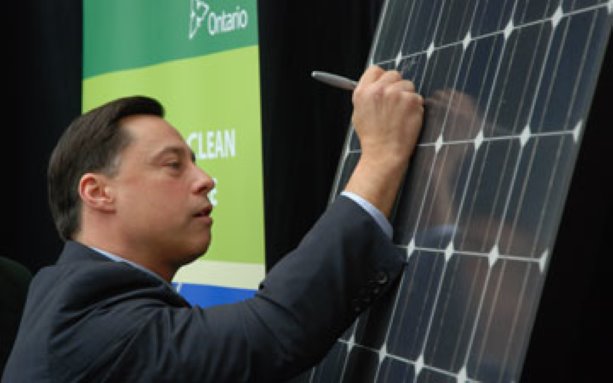Markham’s leadership in becoming the first Ontario municipality to power up a green energy project under the province’s feed-in-tariff program is an example for all to follow, says Ontario’s energy minister.
staff writer
Markham’s leadership in becoming the first Ontario municipality to power up a green energy project under the province’s feed-in-tariff program is an example for all to follow, says Ontario’s energy minister.
“We need to invest in building a clean, reliable, modern energy system if we want to compete in the post-global recession world,” Brad Duguid said on a tour of a local solar installation.
A new 250-kilowatt solar project at the Town of Markham offices on Warden Avenue is the first municipally owned project to provide power under Ontario’s feed-in-tariff (FIT) program.
The rooftop solar array will produce enough clean electricity each year to power 26 homes. A 10-kilowatt solar project at the Markham Civic Centre is also in operation, with live information available online through the SolarVu Energy Portal.
Markham mayor Frank Scarpitti said his municipality’s Greenprint Sustainability plan drove it to pursue ambitious projects through the Ontario FIT program such as the 250-kilowatt solar photovoltaic (PV) system.
Ontario provided Markham with $2.4 million in provincial funding for energy retrofits, facility accessibility improvements and rehabilitation of the Emergency Operations Centre.
“We are now certainly one step closer to being a greener community,” Scarpitti said. “The benefit of installing a solar PV panel is that they can be easily integrated in new and existing buildings.
Ontario’s FIT program has been credited by many construction and electrical industry stakeholders with generating numerous training and work opportunities for electricians, engineers, roofers and other trades. Under the FIT program, the province agrees to purchase power from privately built and maintained solar photovoltaic arrays.
Under Ontario’s recently announced $87-billion, 20-year long-term energy plan, the province has earmarked $14 billion for wind power, $12 billion for conservation programs, $9 billion for solar projects, $9 billion for transmission lines and $4.6 billion on new hydro-electric generation.
By 2018, the plan aims to generate 9,000 new megawatts (MW) of electricity from new hydroelectric sources and 10,700 MW from wind, solar and biomass projects.
Duguid said investments such as Markham’s solar project help reduce Ontario’s reliance on “dirty coal” to generate power and positions the province as a leader and innovator in the green energy field, which helps attract investment.
“It speaks well to our economy and the future green economy,” said Duguid.
In 2003, Ontario had 19 polluting coal units and no solar projects online. Today, there are more than 2,900 solar projects feeding electricity into Ontario’s grid and eight coal units have already been shut down. By 2014, all coal units will be closed, the province has stated.











Recent Comments
comments for this post are closed